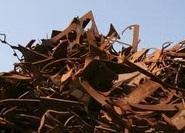Market

July 9, 2020
Scrap Trades Lower by $20-40 Per Ton in July
Written by Tim Triplett
As expected, ferrous scrap prices declined in July, adding downward pressure to already weak finished steel prices. Steel Market Update sources report that obsolete scrap traded down $10-20 per ton, while prime grades were lower by $40 across the country. Scrap supplies have increased at a greater rate than steel production, say the experts, which is the main reason for the declines. The latest declines put the average price for busheling at approximately $275-280/GT, shredded at $235-245/GT and HMS at $205/GT.
Commenting during Steel Market Update’s Community Chat webinar on Wednesday, CRU Senior Analyst Ryan McKinley noted that scrap prices declined steadily in 2019 on weakening steel demand, but were looking up in 2020. “People were expecting to have a really good year until the virus hit. Then steel demand evaporated overnight as did scrap demand.”
Even though steel demand cratered in April/May, prompting mills to dial back production, most of the furnace outages were at integrated mills, which use much less scrap than EAFs. “Quarter to quarter we only saw about a 25 percent drop in scrap demand (from EAFs),” McKinley said.
After the pandemic hit, auto plants curtailed production and scrap collections slowed. Tight scrap supplies lent support to scrap prices. The spread between obsolete and prime grades grew as mills were forced to pay more for prime material, which was in particularly short supply because of the auto shutdowns. Since then the auto restarts have put much more prime scrap into the market, demolition activity is up, as well as peddler traffic into scrap yards. Scrap supplies have grown faster than demand, leading to the lower prices in July, McKinley explained.
China has emerged as a sizable importer of metallics, in particular pig iron, which is used to dilute the impurities in remelted scrap. Chinese demand has allowed pig iron prices to stay relatively stable even though the coronavirus crisis has dampened steel demand in the U.S. and around the world. “The pig iron price remaining stable has also helped propel that large gap between obsolete and prime grades of scrap,” McKinley noted.
CRU’s forecast for ferrous scrap calls for additional downward price pressure through Q3 and probably into Q4. Two factors are at play, McKinley said. First, even if the economy recovers and demand for steel sheet increases, it’s integrated production that will come back online, and integrated mills don’t consume much scrap relative to EAF producers. Second, construction activity will see a seasonal slowdown in the fall, reducing demand for long products such as rebar, which are produced in the U.S. entirely by EAFs, which consume a lot of scrap. “Once the market bottoms in the October timeframe, we will see scrap prices rise seasonally as winter weather starts to impede scrap collection. That will tighten the market and allow prices to go up, which happens essentially every year,” McKinley predicted.
Longer term, as more EAFs come online in the U.S., McKinley see the possibility that scrap prices will become even more volatile. “Over time that could result in a change in the way scrap is bought and sold. With increased volatility, scrap sellers and mills could be motivated to trade more regularly. Instead of having a buy week once a month, it could be every two weeks or perhaps even weekly. In the case of Turkey, their prices change every single day.”
Another Point of View
“Over the course of June, scrap flows, especially for prime scrap, improved while mill order books really did not. Add to that, there reportedly is an HRC inventory build-up from before the COVID shutdowns that needs to be worked off before mill order books can begin to improve. So, the tale of the tape for the July trade was a real supply-demand imbalance, and it’s unclear exactly when it will correct,” commented a dealer in the Northeast.
“With all that said, inbound flows to scrap yards for obsolete grades remain well off last year’s levels by 20-40 percent. The July price drops will exacerbate those poor flows. While we are not quite at the shredder feed price lows reached last October, we are back to prices from November 2019.
“On top of that, export demand and pricing have remained much more firm than domestic pricing with the latest 80/20 deals from the U.S. valued at $255/MT CIF give or take, down only about $10 from their peak in June. It feels like we are at the bottom of that market, and we could creep a little higher back toward $260 when the Turkish mills return to purchase scrap for August deliveries.
“So, between the already poor flows before the July price drop and the new prices, I’m not sure there is much more room for obsolete grades to go down. Looking forward, I expect sideways to lower prime prices in August, and probably sideways prices for obsolete grades. When scrap prices move materially higher again depends on mill demand, and that could be several months away at this point,” he said.
The post Scrap Trades Lower by $20-40 Per Ton in July appeared first on Steel Market Update.






